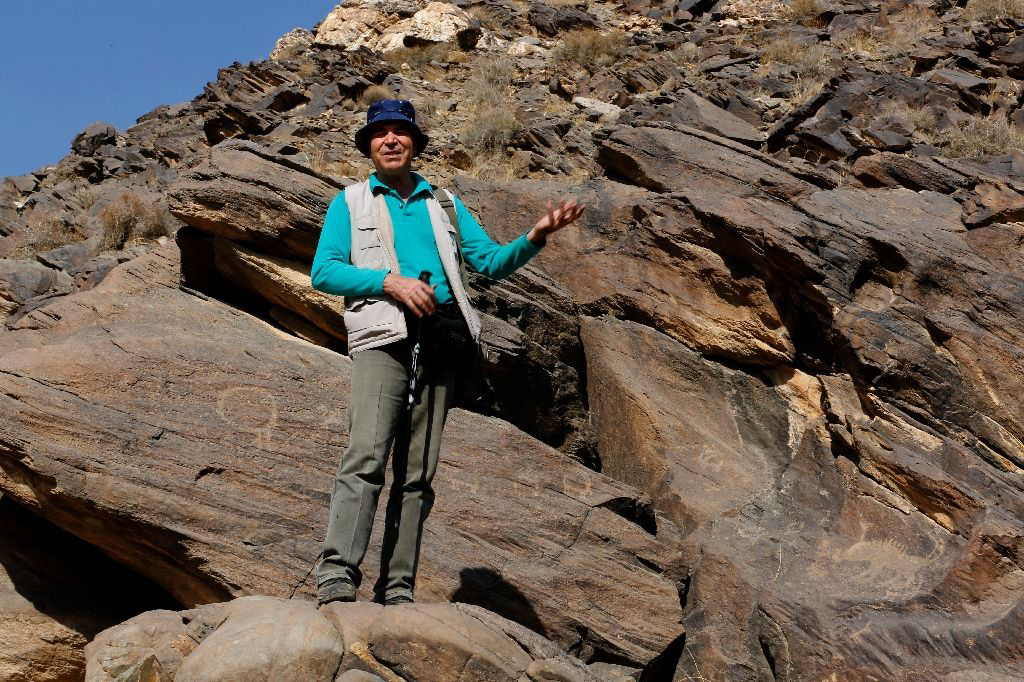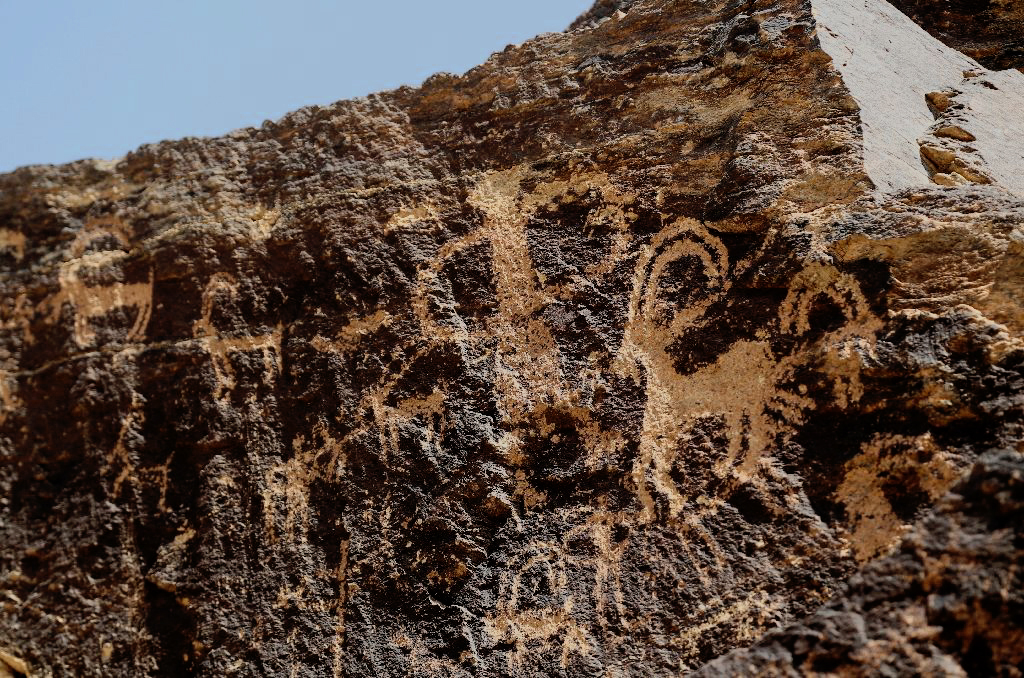


An article by Eric Randolph in Iran for AFP - The ibex code: deciphering Iran's ancient rock art - reports on the research of Iranian archaeologist Mohammed Naserifard who hopes that renewed ties with the West could help decipher the mysteries of ancient rock art.

Iranian archaeologist Mohammed Naserifard with examples of rock art engravings in the hills outside of Khomein. Image: AFP Photo/ATTA KENARE
An Iranian archaeologist has spent years in an almost single-handed quest across the country's hills and desert plains to uncover ancient rock art that could be among the oldest in the world. Now he hopes that renewed ties with the West after years of international isolation could help decipher its mysteries.
the ibex code: deciphering Iran's ancient rock art https://t.co/kR17kuERpO #RockArt #archaeology #Iran pic.twitter.com/H3Uny8JoY1
— Bradshaw Foundation (@BradshawFND) December 13, 2016
The ancient Iranian ibex engravings may have been part of an origin myth, or an attempt to summon magical hunting powers. Image: AFP Photo/ATTA KENARE.
Despite its rough beauty, it is hard to imagine that the desolate, rock-strewn landscape outside the town of Khomein in central Iran conceals any treasures. But Dr Mohammed Naserifard scrambles up a hillside, and waits eagerly at the top, his walking stick pointing out the long curled horns of a 4,000-year-old ibex deer scratched into a flat stone.
Over the next few hours, he leads AFP on a journey through valleys and up steep slopes, revealing dozens more images of ancient hunters, tribal dances, deities and beasts. Despite their potential world-historical importance, they have been seen by just a handful of people.
All are thousands of years old, but some of the markings - such as a line of cup-marks that may have been used in religious ceremonies - could be much older.
Dutch enthusiasts who visited the area with Naserifard in 2008 dated the cup marks to more than 40,000 years ago, putting them among the oldest rock art on the planet.

Ancient engravings of ibex deer in the hills outside of Khomein, Iran may be some 4,000 years old. Image: AFP Photo/ATTA KENARE.
But getting definitive data has been all but impossible for Iranian archaeologists. "Sanctions have deprived us of the technology," Naserifard told AFP. "We hope with the situation improving now, we can soon bring this technology to Iran and gain more accurate and scientific information on these engravings."
Finding a treasure
The sanctions imposed by world powers prior to last year's nuclear deal meant Iranian scientists were cut off from their global colleagues, deprived of modern lab equipment and the latest research, and faced severe funding shortages. Added to that was the fact that rock art has never been a priority in Iran, where pre-Islamic history can be a controversial subject.
It has been left instead to Naserifard's personal determination. Having read about the subject in a German magazine, he hunted everywhere for examples. Then one day in 2002, in the hills outside Khomein, he got lucky.
"We were on a picnic and all my friends were taking an afternoon nap. I went wandering and observing the rocks in the valley and I found a rock full of shapes," he recalled. "I was so excited! Finding these works was like finding a treasure." He estimates he has since travelled more than 700,000 kilometres (450,000 miles) across two dozen Iranian provinces, unearthing some 50,000 ancient paintings and engravings.
Naserifard now teaches at a local university, and his discoveries have been catalogued by the Bradshaw Foundation, a Swiss NGO specialising in rock art, bringing them international attention.
"His work is really important - there have been these blank spots on the map that we are finally starting to fill in," said Genevieve von Petzinger, a Canadian cave art expert and author of "The First Signs: Unlocking the Mysteries of the World's Oldest Symbols". The engravings could even date back to when humans made their first forays out of Africa, she said.
Eerie similarities
Naserifard's discoveries support the growing evidence that humans may have started to develop a common art tradition before leaving Africa, which might explain why the same themes and shapes have turned up in sites as far-flung as California, Spain and South Africa.
"Iran could be a really important part of the puzzle. It is a very strategic location - humans migrated through there heading both east and west," said von Petzinger.
New methods such as uranium dating - which enables scientists to date samples even older than is possible with carbon dating - are now needed in Iran, along with broader archaeological work to put the findings in context. "These new methods are very expensive," said von Petzinger. "Dr Naserifard has done all this diligent work, but he needs access to the big labs. Hopefully, people can now come to help him."
The Khomein hills are typical of rock art locations around the world - a once-fertile riverside spot that supported sizeable settlements. As in other places around the world, the artists were fixated by a single image: in Iran, pictures of the ibex deer account for more than 90 percent of the ancient engravings catalogued by Naserifard.
The Coso hunters of California obsessively drew and redrew the big-horned sheep that looks surprisingly similar. "We don't know why they picked a favourite motif and ran with it, but we see the same pattern in very different places," said Peter Robinson of the Bradshaw Foundation.
He said the ibex may have been part of an origin myth, or perhaps the engravings were an attempt to summon magical hunting powers or encourage the deer to multiply.
"The similarities across time and space can be eerie. We see examples in which Ice Age art didn't vary across 30,000 years," said Robinson. "But one thing that seems clear is this innate human characteristic to want to mark a wall, to graffiti."
Visit the Middle East Rock Art Archive - Iran Rock Art:
http://www.bradshawfoundation.com/middle_east/iran_rock_art/index.php
by Bradshaw Foundation
Wednesday 23 July 2025
by Bradshaw Foundation
Thursday 29 May 2025
by Bradshaw Foundation
Monday 03 February 2025
by Bradshaw Foundation
Monday 30 May 2022
by Bradshaw Foundation
Wednesday 19 January 2022
by Bradshaw Foundation
Thursday 06 January 2022
by Bradshaw Foundation
Tuesday 21 March 2023
by Bradshaw Foundation
Tuesday 07 February 2023
by Bradshaw Foundation
Thursday 19 May 2022
by Bradshaw Foundation
Monday 04 December 2023
by Bradshaw Foundation
Friday 30 June 2023
by Bradshaw Foundation
Thursday 06 April 2023
by Bradshaw Foundation
Friday 14 July 2023
by Bradshaw Foundation
Monday 22 November 2021
by Bradshaw Foundation
Tuesday 12 July 2016
by Bradshaw Foundation
Tuesday 26 November 2024
by Bradshaw Foundation
Monday 27 November 2023
by Bradshaw Foundation
Friday 07 October 2022
by Bradshaw Foundation
Wednesday 23 July 2025
by Bradshaw Foundation
Thursday 29 May 2025
by Bradshaw Foundation
Monday 03 February 2025
by Bradshaw Foundation
Monday 30 May 2022
by Bradshaw Foundation
Wednesday 19 January 2022
by Bradshaw Foundation
Thursday 06 January 2022
by Bradshaw Foundation
Tuesday 21 March 2023
by Bradshaw Foundation
Tuesday 07 February 2023
by Bradshaw Foundation
Thursday 19 May 2022
by Bradshaw Foundation
Monday 04 December 2023
by Bradshaw Foundation
Friday 30 June 2023
by Bradshaw Foundation
Thursday 06 April 2023
by Bradshaw Foundation
Friday 14 July 2023
by Bradshaw Foundation
Monday 22 November 2021
by Bradshaw Foundation
Tuesday 12 July 2016
by Bradshaw Foundation
Tuesday 26 November 2024
by Bradshaw Foundation
Monday 27 November 2023
by Bradshaw Foundation
Friday 07 October 2022
by Bradshaw Foundation
Tuesday 19 November 2024
by Bradshaw Foundation
Wednesday 22 May 2024
by Bradshaw Foundation
Friday 10 November 2023
Friend of the Foundation











